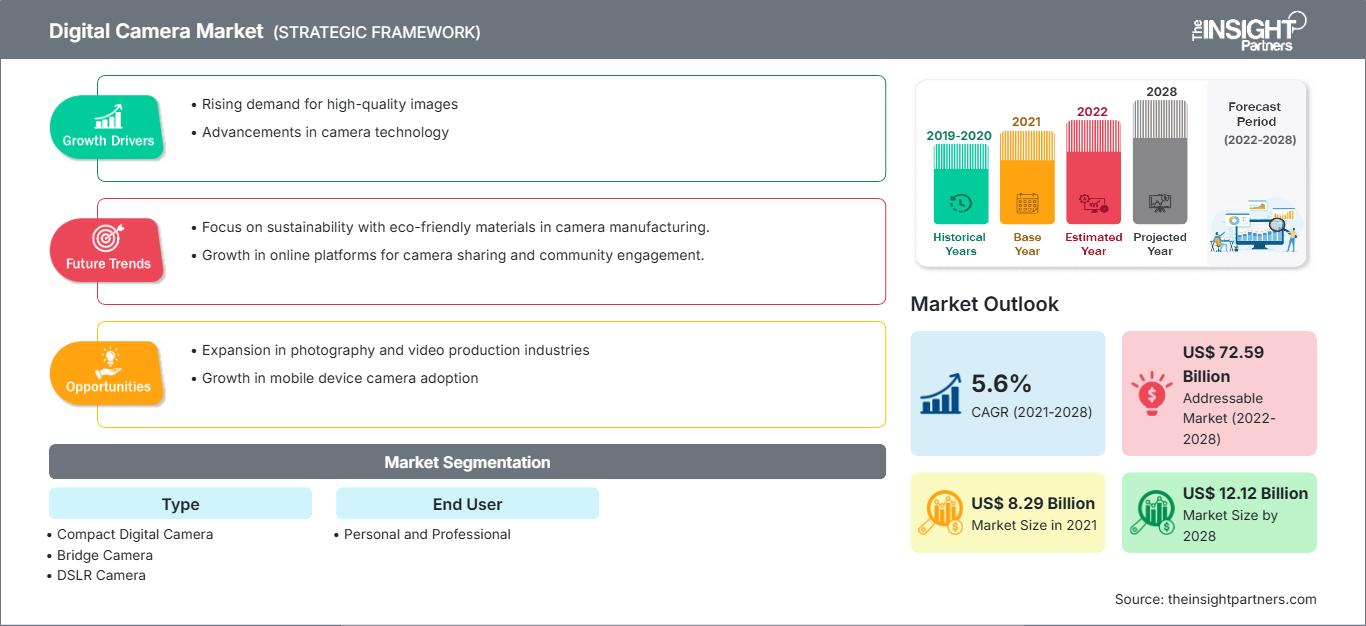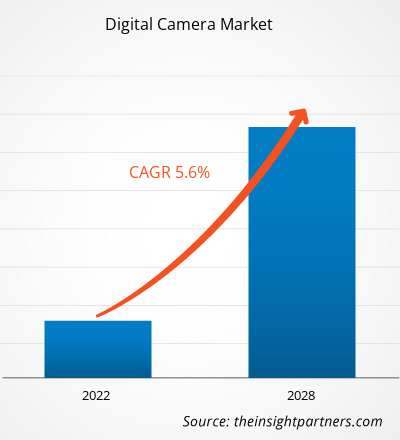Der Markt für Digitalkameras soll von 8.290,25 Millionen US-Dollar im Jahr 2021 auf 12.119,44 Millionen US-Dollar im Jahr 2028 wachsen; für den Zeitraum 2021–2028 wird eine durchschnittliche jährliche Wachstumsrate (CAGR) von 5,6 % erwartet.
Digitalkameras werden nicht nur auf die private und professionelle Fotografie verwendet, sondern finden auch in der Unterhaltungs-, Medien- und Sportbranche Verwendung. Die Filmindustrie ist eine der größten und lukrativsten Kategorien der globalen Unterhaltungsindustrie. Chinas Filmindustrie beispielsweise ist eine der weltweit größten und erwirtschaftete 2016 einen Umsatz von rund 6,6 Milliarden US-Dollar. Diese vielversprechenden Aussichten für die Film- und Unterhaltungsindustrie werden voraussichtlich die Nachfrage nach Digitalkameras für perfekte Aufnahmen und Videos ankurbeln. Rasante technologische Veränderungen, Verbraucherverhalten und Geschäftsmodelle haben die Art und Weise verändert, wie Verbraucher Unterhaltung und Medien erleben und dafür bezahlen möchten. Die führenden Unternehmen dieser Branche konzentrieren sich auf den Aufbau fanorientierter Unternehmen und Marken, um herausragende Inhalte zu produzieren. Daher investieren sie erheblich in Technologien und Ausrüstung wie computergenerierte Bilder (CGI) und visuelle Effekte (VFX) sowie moderne Kameras. Auch der Einsatz von Digitalkameras in Sportmedien ist unverzichtbar. Die Installation von Hochgeschwindigkeits- und Digitalkameras in Stadien ermöglicht den Zuschauern Zeitlupenwiederholungen kritischer Spielsituationen und trägt so zu einer präzisen Wiedergabe bei. Ebenso trägt der Einsatz hochauflösender Digitalkameras in der Tier-, Landschafts-, Architektur- und Studiofotografie zu scharfen und klaren Bildern und Videos bei. Der zunehmende Fokus auf Actionfotografie hat die Nachfrage nach kompakten Digitalkameras wie GoPro gefördert. Darüber hinaus haben Social-Media-Plattformen wie Instagram die Möglichkeiten der Fotografie erheblich erweitert, was wiederum das Wachstum des Digitalkameramarktes voraussichtlich befeuern wird.
Passen Sie diesen Bericht Ihren Anforderungen an
Sie erhalten kostenlos Anpassungen an jedem Bericht, einschließlich Teilen dieses Berichts oder einer Analyse auf Länderebene, eines Excel-Datenpakets sowie tolle Angebote und Rabatte für Start-ups und Universitäten.
Markt für Digitalkameras: Strategische Einblicke

-
Holen Sie sich die wichtigsten Markttrends aus diesem Bericht.Dieses KOSTENLOSE Beispiel umfasst Datenanalysen, die von Markttrends bis hin zu Schätzungen und Prognosen reichen.
Die Coronavirus-Pandemie hat die Wirtschaft und Industrie in verschiedenen Ländern durch Lockdowns, Reiseverbote und Betriebsschließungen stark beeinträchtigt. Die Unterhaltungselektronikbranche ist eine der wichtigsten Branchen, die aufgrund der Pandemie unter schwerwiegenden Störungen wie Lieferkettenunterbrechungen und Produktionsschließungen leidet. Die Schließung verschiedener Produktionsstätten und Fabriken in führenden Regionen wie Nordamerika, Europa, Asien-Pazifik, Südamerika, dem Nahen Osten und Afrika hat die globale Lieferkette beeinträchtigt und sich negativ auf die Produktion, die Lieferzeiten und den Verkauf verschiedener Waren ausgewirkt. Darüber hinaus haben verschiedene Unternehmen bereits mögliche Verzögerungen bei Produktlieferungen und einen Rückgang der zukünftigen Verkäufe ihrer Produkte angekündigt. Darüber hinaus beeinträchtigen die von Ländern in Europa, Asien und Nordamerika verhängten weltweiten Reiseverbote die Möglichkeiten für Geschäftskooperationen und Partnerschaften. All diese Faktoren werden sich voraussichtlich negativ auf die Unterhaltungselektronikbranche auswirken und somit das Wachstum verschiedener mit dieser Branche verbundener Märkte in den kommenden Monaten bremsen. Der Markt für Digitalkameras ist aufgrund von Produktionsausfällen und eingeschränkten Transportmöglichkeiten von der Pandemie betroffen.
Markteinblicke für Digitalkameras: Technologische Innovationen im Zusammenhang mit Digitalkameras kurbeln das Wachstum des Digitalkameramarkts an
Der Markt für Digitalkameras ist eng mit aufkommenden radikalen Trends verbunden, die von innovativen technologischen Entwicklungen und robusten Fortschritten wie HD und Touchscreen unterstützt werden. Aufgrund der zunehmenden Vorliebe der Verbraucher für anspruchsvolle Fotografie ist seit langem eine höhere Nachfrage nach digitalen Spiegelreflexkameras und SLR-Kameras zu verzeichnen. Der technologische Fortschritt hat jedoch zur Entwicklung von hochauflösenden Kameras mit 12–20 Megapixeln geführt. Die kontinuierliche Weiterentwicklung im Bereich der Digitalkameras hat zur Entwicklung fortschrittlicher Kameras mit besserer Auflösung, schnellerer Fokussierung und Unterstützung verschiedener Peripheriegeräte geführt. Außerdem ist ein zunehmender Trend zu beobachten, Digitalkameras mit WLAN- oder 4G-Modems auszustatten, um einen Wettbewerbsvorteil gegenüber Smartphones zu erzielen. Darüber hinaus werden solche Kameras voraussichtlich Teil mehrerer vernetzter Geräte sein, wie beispielsweise des IoT (Internet of Things), was in naher Zukunft eine effektive Kommunikation mit anderen vernetzten Geräten wie Smartphones und Lautsprecherassistenten ermöglichen könnte.
Typbasierte Markteinblicke
Basierend auf dem Typ wird der Digitalkameramarkt in Kompaktdigitalkameras, Bridgekameras, DSLR-Kameras, spiegellose Kameras, digitale Messsucherkameras und Zeilenkameras unterteilt. Im Jahr 2020 hatte das DSLR-Kamerasegment den größten Marktanteil.
Regionale Einblicke in den Digitalkameramarkt
Die Analysten von The Insight Partners haben die regionalen Trends und Faktoren, die den Digitalkameramarkt im Prognosezeitraum beeinflussen, ausführlich erläutert. In diesem Abschnitt werden auch die Marktsegmente und die geografische Lage in Nordamerika, Europa, dem asiatisch-pazifischen Raum, dem Nahen Osten und Afrika sowie Süd- und Mittelamerika erörtert.
Umfang des Marktberichts für Digitalkameras
| Berichtsattribut | Einzelheiten |
|---|---|
| Marktgröße in 2021 | US$ 8.29 Billion |
| Marktgröße nach 2028 | US$ 12.12 Billion |
| Globale CAGR (2021 - 2028) | 5.6% |
| Historische Daten | 2019-2020 |
| Prognosezeitraum | 2022-2028 |
| Abgedeckte Segmente |
By Typ
|
| Abgedeckte Regionen und Länder |
Nordamerika
|
| Marktführer und wichtige Unternehmensprofile |
|
Dichte der Marktteilnehmer für Digitalkameras: Ihre Auswirkungen auf die Geschäftsdynamik verstehen
Der Markt für Digitalkameras wächst rasant. Die steigende Nachfrage der Endverbraucher ist auf Faktoren wie veränderte Verbraucherpräferenzen, technologische Fortschritte und ein stärkeres Bewusstsein für die Produktvorteile zurückzuführen. Mit der steigenden Nachfrage erweitern Unternehmen ihr Angebot, entwickeln Innovationen, um den Bedürfnissen der Verbraucher gerecht zu werden, und nutzen neue Trends, was das Marktwachstum weiter ankurbelt.

- Holen Sie sich die Markt für Digitalkameras Übersicht der wichtigsten Akteure
Basierend auf der Anwendung ist der Markt für Digitalkameras in private und professionelle Kameras unterteilt. Im Jahr 2020 hatte das professionelle Segment einen größeren Marktanteil.
Die Akteure des digitalen Marktes verfolgen Strategien wie Fusionen, Übernahmen und Marktinitiativen, um ihre Position auf dem Markt zu behaupten. Einige Entwicklungen der wichtigsten Akteure sind unten aufgeführt:
- FUJIFILM Holdings Corporation gab Ende Februar 2021 die Markteinführung der FUJIFILM GFX100S bekannt. Die Kamera ist das neueste Mitglied der GFX-Serie spiegelloser Digitalkameras.
- Nikon Corporation hat die spiegellose Vollformatkamera Z 7II auf den Markt gebracht. Die Z 7II ist eine spiegellose Vollformatkamera mit hoher Auflösung. Durch solche Produkteinführungen trägt das Unternehmen zur Entwicklung der Bildkultur bei.
Der Markt für Digitalkameras ist wie folgt segmentiert:
Nach Typ
- Kompakte Digitalkamera
- Bridgekamera
- DSLR-Kamera
- Spiegellose Kamera
- Digitale Messsucherkamera
- Zeilenkamera
Nach Endbenutzer
- Privat
- Professionell
Nach Geografie
-
Nordamerika
- USA
- Kanada
- Mexiko
-
Europa
- Frankreich
- Deutschland
- Italien
- Großbritannien
- Russland
- Rest Europa
-
Asien-Pazifik (APAC)
- China
- Indien
- Südkorea
- Japan
- Australien
- Rest von APAC
-
Naher Osten und Afrika (MEA)
- Südafrika
- Saudi-Arabien
- VAE
- Rest von MEA
-
Südamerika (SAM)
- Brasilien
- Argentinien
- Rest von SAM
Firmenprofile
- Canon Inc.
- Eastman Kodak Company
- Fujifilm Holdings Corporation
- Leica Camera Ag
- Nikon Corporation
- Om Digital Solutions Corporation
- Panasonic Corporation
- Hasselblad
- Ricoh Imaging Company, Ltd,
- Sony Corporation
- Historische Analyse (2 Jahre), Basisjahr, Prognose (7 Jahre) mit CAGR
- PEST- und SWOT-Analyse
- Marktgröße Wert/Volumen – Global, Regional, Land
- Branchen- und Wettbewerbslandschaft
- Excel-Datensatz
Aktuelle Berichte
Verwandte Berichte
Erfahrungsberichte
Grund zum Kauf
- Fundierte Entscheidungsfindung
- Marktdynamik verstehen
- Wettbewerbsanalyse
- Kundeneinblicke
- Marktprognosen
- Risikominimierung
- Strategische Planung
- Investitionsbegründung
- Identifizierung neuer Märkte
- Verbesserung von Marketingstrategien
- Steigerung der Betriebseffizienz
- Anpassung an regulatorische Trends






















 Kostenlose Probe anfordern für - Markt für Digitalkameras
Kostenlose Probe anfordern für - Markt für Digitalkameras